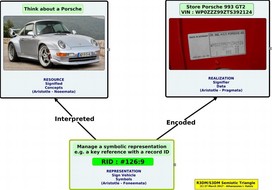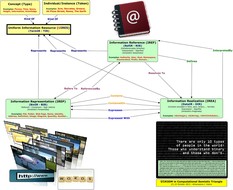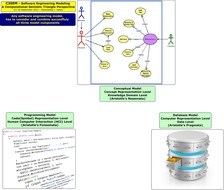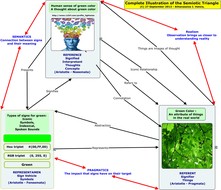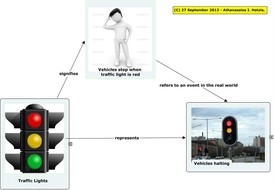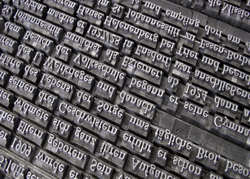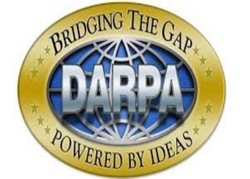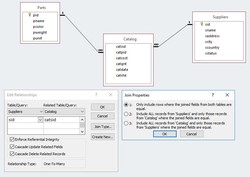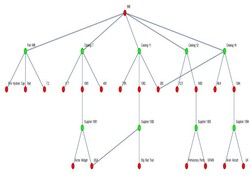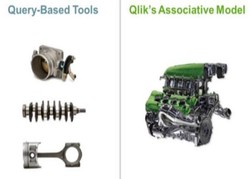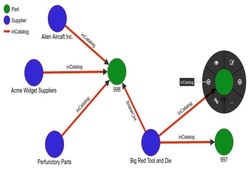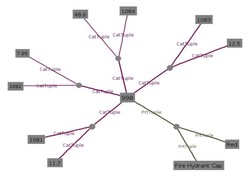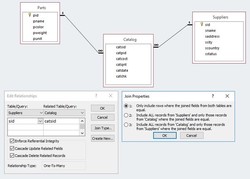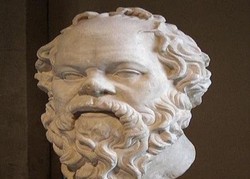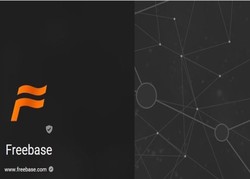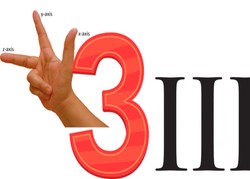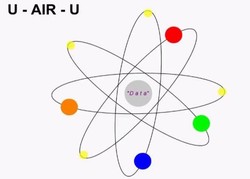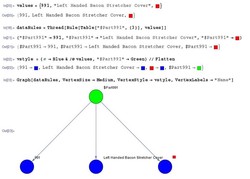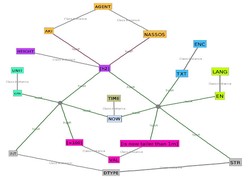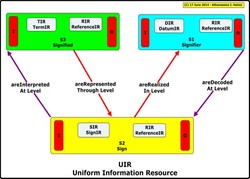Table of Contents
Introduction
S3DM/R3DM is a conceptual framework that formalizes the architectural design of data modeling process in software engineering. It is founded on the concept of Sign from Ancient to Modern Semiotics. S3DM/R3DM framework is based on the powerful theory of the semiotic triangle, a.k.a triangle of reference. We use numerical vectors (signs), to encode abstract things in our mind (signified) to which the sign refers, e.g. Person, name, Car, model. We associate these with data containers-forms that the sign takes for the storage of data values (signifier), i.e. primitive data types (see wikipedia Signified and Signifier article). This trilateral principle of S3DM/R3DM framework permits a uniform treatment of semantics, syntax and storage of information based on a symbolic representation. Next we define a fundamental, atomic information resource unit, (AIR). Those units, in turn, can be easily shaped to form any tabular, hierarchical, or graph data structure in a unified way. Data granularity can be also deeply connected and related to the definition of a fundamental unit of processing.
Computational Semiotic Triangle
- First illustration with porsche
- Second illustration with
- information resources
- information representation
- information realization
- Third illustration with
- concepts
- code
- computer storage
- Illustration with real-world object (green leaves)
- Illustration with an event (traffic lights)
The Core Terms of S3DM/R3DM
There are two sets of base terms one starting with the letter ‘R’ and the other with the letter ‘S’ that we can use in order to convey the fundamental principles of R3DM. Both of the sets are outlined hierarchically into three levels. Each level is described with one or more characteristic words that are useful for memorizing and recapitulating the distinguishing features of R3DM.
STerms
-
S3 : Signified, Sense, Semantic - Signify
- Signified, in Greek “σημαινόμενον”, to mean something
-
S2 : Sign, Symbol, Syntax, Structure - SymbolizeS2 : Sign, Symbol, Syntax, Structure - Symbolize
- Sign, in Greek “σημείο”
-
S1 : Signifier, Storage (String) - Store
- Signifier, in Greek “σημαίνον”
RTerms
-
R3 : Information Resource - InfoRes (Enity) - Originate
-
R2 : Information Representation - InfoRes (Symbol) - Represented
-
R1 : Information Realization (Datum) - Realized
Other Terms
There are also other terms that are often used when we describe relations, operations and features in R3DM these are:
- Referenced
- Interpreted
- Formatted
- Expressed
- Decoded
- Encoded
- Parsed
Trilateral Relations
The trilateral schema of relations between R1, R2 and R3 or equally between S1, S2, S3 defines the core mechanism of semiosis. We will use the terms we defined in previous section to build simple sentences that convey the full meaning. We will also use three prepositions “from”, “through” and “in” that accompany RTerms and STerms in a specific order that signifies the left to right direction of abstraction
-
Direction from S1 through S2 in S3
- Data from S1 are Symbolized through S2 and Signified in S3
- Data from S1 are Decoded through S2 and Interpreted in S3
- Realization from S1 is Parsed through S2 and Interpreted in S3
-
Direction from S3 through S2 in S1
- Information Resources from S3 are Represented through S2 and Realized in S1
- Information Resources from S3 are Represented through S2 and Encoded in S1
- Information Resources from S3 are Represented through S2 and Formatted in S1
S3DM/R3DM Dogma
With the term dogma we want to bring together a set of R3DM principles laid down by an authority as incontrovertibly true. R3DM dogma serves as part of the primary basis of R3DM modelling system, and it cannot be changed or discarded without affecting the very system’s paradigm. R3DM is serving one purpose to become the paradigm of paradigms, the metamodel of metamodels.
S3DM/R3DM Formalization v2.0
-
S3DM/R3DM is a conceptual model of an information processing system based on semiosis. S3DM/R3DM fundamental construct is the uniform information RESOURCE (UIR), i.e. a parent class of the following three derived subclasses :
-
A Term Information Resource (TIR) models any concept, subject, topic, idea at a highest level, S3, i.e. sense, context level, of abstraction. TIR is also called the signified information resource
-
On the next, intermediate level, S2 - sign level, a Sign Information Resource (SIR), models the notion of the sign in semiotics. Therefore (TIR) is REPRESENTED by (SIR).
-
Finally at level, S1, i.e. data level, (SIR) conveys information that are encoded inside a data container, i.e. Datum Information Resource (DIR), signifier. The content inside (DIR), i.e. data, is expressed with an atomic or complex data structure and REALIZED with operations on data. Therefore (SIR) is REALIZED by (DIR).
-
In all the levels, S3, S2, S1 of abstraction references are created and maintained for the context of the signified concept (S3), the construction of signs (S2), and for the addressing of containers and the indexing of content that express signifiers (S1). Thus, information resources are REFERENCED differently depending on the level of abstraction by a Reference Information Resource (RIR).
There is also a hidden level S0, machine-system level, where everything is encoded and expressed with a sequence of binary digits but this currently out of our scope.

Memorizing the formula
In a concise way S3DM/R3DM can be described in any of the following memorable ways
-
S3DM/R3DM Edges - Duality of Sign
- Any Sign at level S2 is correlated to a Signifier at level S1 and the Signified at level S3
-
S3DM/R3DM Nodes - Triadic Relationship
- Any information RESOURCE at level S3 can be REPRESENTED at level S2 and REALIZED at level S1 using a different REFERENCE mechanism at each level.
-
S3DM/R3DM Nodes - Triadic Relationship
- Information RESOURCES are REPRESENTED, REALIZED and REFERENCED
-
S3DM/R3DM Nodes - Triadic Relationship
- Information RESOURCES are originated FROM level S3, are represented THROUGH level S2 and encoded IN level S1
S3DM/R3DM Formalization v1.0
In fact it occurs that this formalization is also the first attempt to formalize the notion of the word “plerophoria”, i.e. information translated in Greek, using Aristotle’s semiotic triangle of meaning.
S3DM/R3DM models any concept C at a highest level, L2, of abstraction.
Information RESOURCES about that concept are REPRESENTED and consequently encoded using a combination of signs S at an intermediate level, L1, into a message M.
Then at the lowest level, L0, the content of M is expressed with a complex data structure D and REALIZED with operations on data containers.
In all L0, L1, L2 levels of abstraction, we maintain REFERENCES for the context (L2), for the construction of signs (L1), and for the addressing of containers and the indexing of content (L0).
The Trilateral Principle
Resource, symbol and data, each plays a distinct role but they are united with a trilateral relationship and act as one thing. They are present at every level of R3DM as
- or
In fact you cannot separate these three things in any computer engineering architecture, the signifier (the concept, semantics), the symbol (serialization, syntax), and the signified (storage, data form, i.e. strings, numbers, bits). They stay together from the lowest level of abstraction, to the highest level. You can only link these meaning triangles side by side and move in two directions, specialization or generalization, Sowa Ontology, Metadata, and Semiotics.
Symbol’s Duality Principle
There is a duality on the characteristics of a sign. Symbols play two roles at the same time that of a container and content. These roles cannot be separated, they always come in pairs. You may think in terms of how computer memory works to understand this. In digital computers EVERYTHING is represented with a sequence of bits, but this sequence is stored in an array of memory cells. Therefore any such fundamental construct, i.e. data structure, that can be build at a higher level should comply with a symmetrical design, i.e. Types, Instances, Values, and Relations-Associations all of them have to be constructed from these atomic fundamental constructs.
The Threefold Tower of Babel in Information Technology
A concise synopsis of the chaotic situation that is present in information technology is this:
The user is experiencing a threefold Tower of Babel
- in semantic web and linked data - conceptual modelling,
- in computer programming - symbolic modelling
- in persistent or temporary storage and retrieval of information - data modelling.

Cross-References
- HEALIS - 20120920 Ignite Athens 2012
- LinkedIn - 20130920 Topic Maps Community
- LinkedIn - 20130920 Linked Data Web
- LinkedIn - 20130920 Semantic Technologies
- LinkedIn - 20130920 Database Developers and Architects Group
- LinkedIn - 20130923 Linked Data Web
- LinkedIn - 20130925 Semantic Web Research - URI Identity Crisis
- LinkedIn - 20130927 Semantic Web Research
- LinkedIn - 20131129 Computational Semiotics - The Variable-Value Pair
- LinkedIn - 20131129 Semantic Web Research - The Variable-Value Pair
- LinkedIn - 20131129 Topic Maps Community - The loss of interest in Topic Maps
- LinkedIn - 20131205 Semantic Web Research - About a better layered semantic structure
- LinkedIn - 20131212 Semantic Web Research - How about a noSPARQL and noLinked Data movement
- LinkedIn - 20131213 Semantic Web Research - Linked Data, an unnecessarily complicated technology
- LinkedIn - 20131213 NoSQL - How about a noSPARQL and noLinked Data movement
- LinkedIn - 20131213 Chief Information Security Officer - How about a noSPARQL….
- LinkedIn - 20131213 Graph Databases - How about a noSPARQL and noLinked Data movement
- LinkedIn - 20131219 Semantic Web Research - Retrofitting, the reality, (CubeWeb)
- LinkedIn - 20140109 Semantic Web Research - The best debate ever in computer science
- LinkedIn - 20140109 Topic Maps Community - The best debate ever in computer science
- LinkedIn - 20140307 Semantic Web Research - R3DM All right, All right, All right
- LinkedIn - 20140307 Semantic Web Research - Data and metadata
- LinkedIn - 20140416 Semantic Web Research - R3DM Conceptual Model Explained
- LinkedIn - 20140416 Semantic Web Research - R3DM a glimpse from the future
- LinkedIn - 20140417 Computational Semiotics - R3DM A computational semiotics interpretation
- LinkedIn - 20140428 Computational Semiotics - R3DM An explanation of the identity crisis
- LinkedIn - 20140428 Semantic Web Research - R3DM An explanation of the identity crisis
- LinkedIn - 20140430 Semantic Web Research - Something very big is coming Wolfram Language
- LinkedIn - 20140509 Semantic Web Research - Linked Data vs Linked Documents
- LinkedIn - 20140613 Computational Semiotics - Information vs Plerophoria
- LinkedIn - 20140613 Computational Semiotics - First Attempt to Formalise R3DM
- LinkedIn - 20140613 Semantic Web Research - R3DM Formalization v1
- LinkedIn - 20140617 Semantic Web Research - R3DM Formalization v2
- LinkedIn - 20140617 Computational Semiotics - R3DM Formalization v2
- LinkedIn - 20140617 Functional Programming - Best paradigm for implementing R3DM
- LinkedIn - 20140629 Semantic Web Research - Crossroad of Database, Functional Programming and Semantics
- LinkedIn - 20140802 Semantic Web Research - The Threefold Tower of Babel in Information Technology
- LinkedIn - 20140802 Mathematica Users - The Threefold Tower of Babel in Information Technology
- LinkedIn - 20140802 Artificial Intelligence - The Threefold Tower of Babel in Information Technology
- LinkedIn - 20140802 Topic Maps Community - The Threefold Tower of Babel in Information Technology
- LinkedIn - 20140802 Computational Semiotics - R3DM perspective on Wolfram Technology
- LinkedIn - 20140802 Greek IT Network - The Threefold Tower of Babel in Information Technology
- LinkedIn - 20141010 Topic Maps Community - R3DM: A new paradigm on data modelling
- LinkedIn - 20141010 Semantic Web Research - R3DM: A new paradigm on data modelling
- LinkedIn - 20141010 Mathematica Users - R3DM: A new paradigm on data modelling
- LinkedIn - 20141023 Mathematica Users - The Role of Mathematica in semantic technology
- LinkedIn - 20141027 Semantic Web Research - Semantic Web Research in a poetic style
- LinkedIn - 20141030 Semantic Web Research - AtomicDB
- LinkedIn - 20141103 Semantic Web Research - Connecting values at an atomic level
- LinkedIn - 20141103 Chief Information Security Officer - New paradigm for data modelling in the NoSQL world
- LinkedIn - 20141103 Semantic Web Research - An unusual criticism on RDF
- LinkedIn - 20141104 Semantic Web Research - RDF is that the most basic data model you can think about
- LinkedIn - 20141104 Mathematica Users - Symbolic expressions in mathematica and the RDF model
- LinkedIn - 20141105 NoSQL - Direct linking of two nodes with bidirectional pointers
- LinkedIn - 20141124 Computational Semiotics - The core terms of R3DM from two perspectives
- LinkedIn - 20141124 Computational Semiotics - R3DM Trilateral Relations
- LinkedIn - 20141124 Computational Semiotics - R3DM Principles The Dogma
- LinkedIn - 20141124 Semantic Web Research - R3DM The core mechanism of abstraction
- LinkedIn - 20141230 Semantic Web Research - R3DM What do we really miss in data modelling field
- LinkedIn - 20170317 Computational Semiotics - S3DM/R3DM Triangle of Meaning

